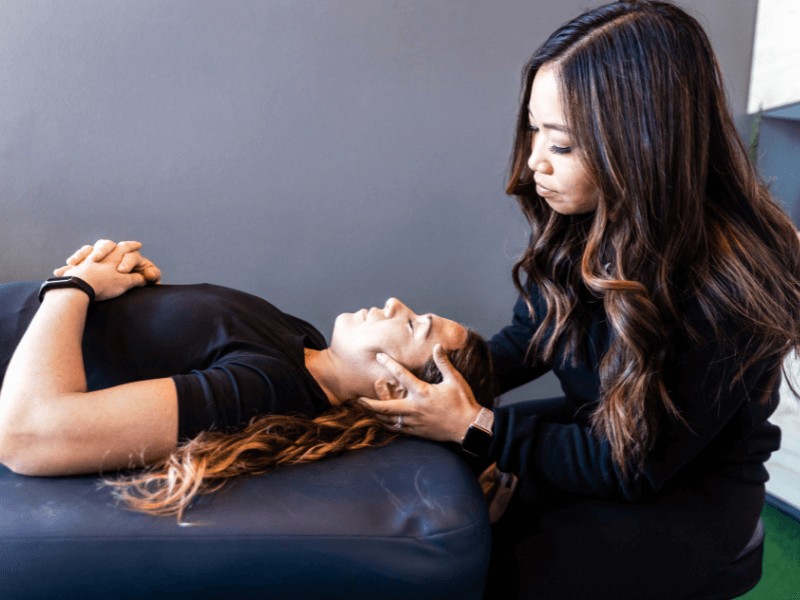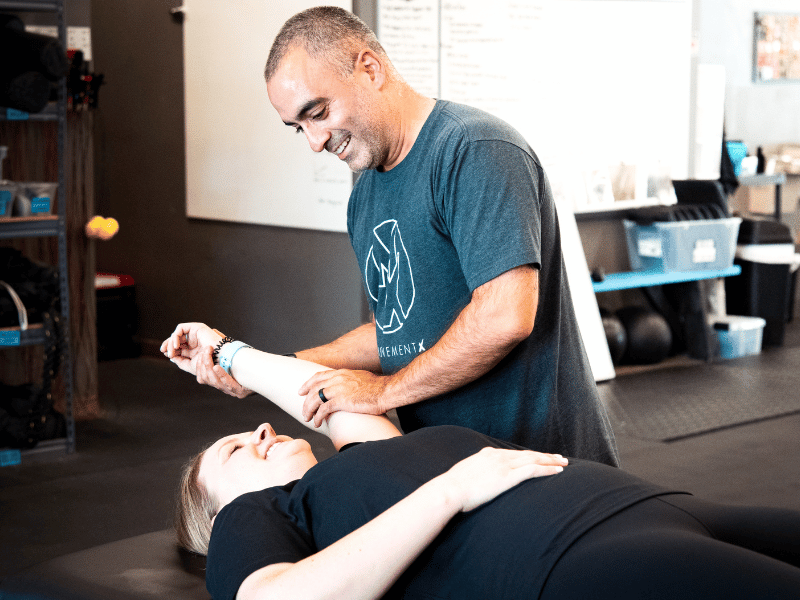Overcoming Frozen Shoulder: How Physical Therapy Helps You Recover From Adhesive Capsulitis
Adhesive capsulitis, more commonly known as “frozen shoulder,” can make everyday activities like reaching for something on a high shelf or putting on a jacket very challenging. Frozen shoulder affects your ability to move freely, making it difficult to maintain your normal level of independence.
Frozen shoulder is more common than you might think, impacting about 2-5% of the general population. It’s most prevalent in adults between the ages of 40 and 60 years, and is more commonly found in women than men. While the exact cause of adhesive capsulitis isn’t fully understood, what’s important to know is that frozen shoulder is treatable. Studies have shown that with the right care, you can regain your mobility and live pain-free.
The good news is that there is hope! During clinical practice we have found that with the correct combination of targeted exercises and manual therapy, we can often shorten the duration of the condition.
In this guide, we’ll be diving deep into the details around adhesive capsulitis, covering everything from its symptoms to the most effective treatment options. We’ll explain how physical therapy plays an absolutely essential role in relieving pain, improving movement, and speeding up recovery. Whether you’re currently experiencing frozen shoulder or seeking prevention tips, this page will offer valuable insights to help your shoulder function return to normal.
What is Adhesive Capsulitis?
Adhesive capsulitis is a condition characterized by stiffness, pain, and a significant reduction in the range of motion in your glenohumeral (shoulder) joint. It occurs when the capsule of connective tissue that surrounds your shoulder joint becomes inflamed and tight, limiting the joint’s ability to move freely. Normally, the glenohumeral joint is extremely mobile (the most mobile joint in the body!), so any restriction can make it very difficult to perform simple tasks like lifting or rotating your arm.
Frozen shoulder typically progresses through three distinct stages, each with varying degrees of pain and restriction:
- Freezing
- Frozen
- Thawing
During the first phase, pain may be the dominant symptom, while later on, stiffness and immobility become more prominent. Over time, if left untreated, a frozen shoulder can severely impact your ability to carry out daily activities or sleep comfortably, which can negatively affect your overall quality of life.
The progression of these three phases can take several months or even up to one to two years. However, physical therapy can significantly reduce the recovery time by helping to improve shoulder mobility, decrease pain, and restore function.
Symptoms of Adhesive Capsulitis
People experiencing frozen shoulder often notice a slow onset of discomfort that worsens over time. As described above, the symptoms typically fall into different stages, each with its own unique challenges.
Here are some of the most common symptoms associated with adhesive capsulitis:
- Pain: The condition often begins with a dull or aching pain in the shoulder that may worsen with movement. This pain is often felt in the outer shoulder or upper arm and may become more severe at night.
- Stiffness: As time goes on, the shoulder joint becomes stiff and tight, making it difficult to move the arm in any direction. This stiffness is one of the most noticeable features of the condition and can severely restrict movement and function.
- Limited Range of Motion: You might find it challenging to perform daily activities, such as reaching overhead, lifting objects, or even brushing your hair.
- Weakness in the Shoulder: Due to the pain and restricted movement, muscles around the shoulder may become weaker over time. When the painful stages eventually subside, this weakness can make it harder to perform tasks that require strength, like lifting or carrying.
- Discomfort or Pain at Rest: While frozen shoulder pain is often linked to movement, you may also experience discomfort even when your shoulder is at rest, particularly in the freezing stage. This can make it hard to find a comfortable position for sleeping.
- Gradual Onset and Progression: Symptoms usually start slowly and worsen over a period of months. The condition can last for several months to years if not properly treated.
Causes of Frozen Shoulder
While the physiological causes of frozen shoulder remain unclear, several risk factors are widely understood to be associated with the condition. These factors can make it more likely for someone to develop adhesive capsulitis, though they aren’t always directly responsible for the onset of the condition.
Here are the common risk factors for frozen shoulder:
- Injury or Surgery: Frozen shoulder can sometimes develop after an injury or surgery involving the shoulder or arm. When movement is restricted due to pain or immobilization, the shoulder joint may become stiff over time.
- Prolonged Immobility: Any condition that limits your ability to move your shoulder for an extended period—such as a fracture, stroke, or recovering from another shoulder issue—can increase the likelihood of developing a frozen shoulder.
- Age and Gender: Adhesive capsulitis tends to occur more frequently in people between the ages of 40 and 60, and it is more common in women than men. Hormonal changes may play a role in this, although the connection isn’t fully understood.
- Diabetes: Studies have shown that people with diabetes, particularly those with type 1 diabetes, have a significantly higher risk of developing frozen shoulders.
- Other Medical Conditions: Certain medical conditions like hypo/hyperthyroidism or rheumatoid arthritis may also increase the risk of developing adhesive capsulitis.
- Inflammatory Processes: Frozen shoulder may result from inflammation in the shoulder joint capsule. This inflammation can lead to the thickening and tightening of the capsule, which restricts movement and causes pain.
While these factors can increase your chances of developing a frozen shoulder, it’s important to remember that the condition sometimes occurs without a clear cause. Understanding your risk factors can be helpful in seeking early intervention and treatment.
Treatment Options for Adhesive Capsulitis
Living with a frozen shoulder can be a frustrating and painful experience, but there are several effective treatment options available to help you regain mobility and reduce discomfort. Treatment typically depends on the severity of the symptoms and how far the condition has progressed. Here are some of the most common approaches advised to treat a frozen shoulder:
- Physical Therapy: One of the most effective treatment options for frozen shoulder is physical therapy. A MovementX physical therapist can guide you through a personalized exercise program designed to gently stretch and strengthen your shoulder. These exercises help improve range of motion, relieve stiffness, and restore function over time. Physical therapy is often considered the first line of treatment and can significantly speed up recovery.
- Medications: Over-the-counter pain relievers like ibuprofen or acetaminophen are sometimes recommended to manage pain and reduce inflammation in the initial painful stage. In more severe cases, prescription anti-inflammatory medications may be advised. These medications won’t cure the condition but may make it easier to engage in exercises and other forms of treatment.
*Please consult with your primary care physician before taking any medication. - Corticosteroid Injections: In cases of severe pain, corticosteroid injections may be administered directly into the shoulder joint. These injections can provide temporary relief by reducing inflammation and allowing greater movement. However, their effects are often temporary and repeated injections may not be recommended due to potential side effects.
- Manipulation Under Anesthesia (MUA): In some cases, if other treatments are not successful, a physician may recommend manipulation under anesthesia. During this procedure, you are placed under general anesthesia, and the doctor moves your shoulder joint through a full range of motion to break up adhesions and improve mobility. Physical therapy is often needed following the procedure to maintain the restored movement.
- Joint Distension (Hydrodilatation): This minimally invasive procedure involves injecting sterile fluid into the shoulder joint to expand the capsule and improve mobility. The fluid stretches the tight shoulder capsule, allowing for more movement and reducing stiffness. This treatment is sometimes used in conjunction with physical therapy to enhance recovery.
- Surgery (Capsular Release): In rare cases, when conservative treatments fail and the condition persists, surgery may be recommended. The procedure, known as capsular release, involves arthroscopic surgery to cut tight areas of the shoulder capsule, allowing for increased movement. Surgery is typically considered a last resort after other treatments have been exhausted.
Most cases of frozen shoulder improve with non-surgical treatments, particularly physical therapy. By focusing on gradually improving shoulder movement and strength, physical therapy offers a long-term solution that addresses the underlying stiffness. In the next section, we’ll dive deeper into how physical therapy plays a crucial role in helping you get back to your daily activities.
How Physical Therapy can help with Frozen Shoulder
Physical therapy plays a critical role in the treatment of frozen shoulder by focusing on restoring mobility, reducing pain, and improving overall shoulder function. When working with a skilled physical therapist for frozen shoulder, you’ll undergo a personalized treatment plan tailored to your specific stage of adhesive capsulitis.
One of the key techniques used in physical therapy is guided stretching. A physical therapist will work with you to gently stretch the tight tissues in your shoulder joint, gradually increasing your range of motion. These stretches are often progressive, meaning they’ll start gently and increase in intensity as your shoulder becomes more mobile.
Manual therapy is another hands-on technique frequently used in treating frozen shoulder. Your therapist may apply specific pressure or manipulate your shoulder joint and surrounding muscles to reduce stiffness and increase flexibility. This form of soft tissue mobilization helps loosen tight muscles and tendons around the shoulder.
As your range of motion improves, your physical therapist should also introduce strengthening exercises. These exercises help rebuild strength in the muscles around the shoulder that may have weakened due to immobility. Strengthening the shoulder muscles helps stabilize the joint and prevent future episodes of stiffness.
In addition to these active approaches, your physical therapist may use modalities such as heat or ultrasound therapy to help relax your muscles and improve blood flow to the affected area. This can make stretching and exercises more comfortable and effective—particularly if you’re dealing with significant pain.
Physical therapy not only addresses the symptoms of frozen shoulder but also equips you with the tools and knowledge to manage your condition long-term. Through consistent treatment and exercises, you’ll experience improved function and a gradual return to your normal activities.
Our Top Exercises & Stretches for Adhesive Capsulitis
Treating frozen shoulder with targeted exercises and stretches can help improve mobility, relieve stiffness, and reduce pain. Since frozen shoulder progresses through three different stages—freezing, frozen, and thawing—the exercises you perform should be tailored to where you are in the recovery process.
Below are three key exercises or stretches that can help at each stage of adhesive capsulitis. Of course, we advise working with a specialized physical therapist and remaining within a pain-free range of motion to avoid aggravating your symptoms.
1. Pendulum Swings (Freezing Phase)
During the freezing phase, shoulder movement may be painful and limited. The goal at this stage is to keep the joint moving as much as possible without causing discomfort. Pendulum swings are a gentle way to keep your shoulder active and loosen up the joint.
How to perform:
- Stand next to a sturdy surface like a table or chair for support.
- Lean forward slightly, allowing your affected arm to hang straight down.
- Use your body to gently swing your arm in small circles, making sure the movement comes from your body and not your shoulder muscles.
- Start with 10 small clockwise circles then switch to 10 counterclockwise.
- Progressively increase the size of the circles as your shoulder loosens.
2. Cross-Body Stretch (Frozen Phase)
As you progress into the frozen phase, your shoulder may be less painful but stiffness often becomes more noticeable. This cross-body stretch can help target the tightness by stretching the shoulder joint capsule and improving flexibility.
How to perform:
- Sit or stand tall with your shoulders relaxed.
- Gently bring your affected arm across your chest, keeping the elbow slightly bent.
- Use your opposite hand to hold the affected arm and apply gentle pressure, pulling the arm closer to your chest.
- Hold the stretch for 15 to 30 seconds then release.
- Repeat 3 to 5 times. Make sure to breathe deeply throughout.
3. Shoulder raise with pulley (Frozen to Thawing phase)
This will require a specialized piece of equipment that you can find online, or by asking a MovementX physical therapist. This exercise will help maintain your ability to reach overhead as well as dress yourself.
How to perform:
- Secure a pulley over the top of a door (close the door on the anchor).
- Gently pull down with your unaffected side while slowly guiding your painful side upwards.
- Hold at the top of the range for 10 seconds then return to your starting position.
- Repeat 3 times per day.
- Some temporary discomfort is to be expected, but don’t provoke lasting pain.
4. Towel Stretch (Thawing Phase)
In the thawing phase, your shoulder is likely regaining motion, and the goal is to continue increasing flexibility and strength. The towel stretch is a great way to stretch the shoulder and improve internal rotation, which is often limited with frozen shoulder.
How to perform:
- Grab a towel or a strap and hold it in both hands behind your back, with one hand reaching over your shoulder and the other behind your back.
- Use your top hand to gently pull the towel upward, stretching the shoulder of the arm below.
- Hold for 15 to 30 seconds then slowly release.
- Switch arms and repeat. Pull with the opposite hand to stretch the other shoulder.
- Perform this exercise 3 to 5 times per side, gradually increasing the range of motion as your shoulder allows.
Prevention of Frozen Shoulder
Preventing adhesive capsulitis involves maintaining shoulder mobility, avoiding prolonged immobility, and addressing any underlying conditions that could contribute to its development. Here are some actionable tips and strategies:
- Perform daily shoulder stretches to keep the shoulder flexible and reduce stiffness.
- Incorporate range-of-motion exercises such as pendulum swings and arm circles to maintain mobility.
- Avoid prolonged immobility by gradually resuming movement after injuries or surgeries. We don’t advise using a shoulder sling after injury unless specifically administered by a health professional.
- Manage underlying health conditions like diabetes and thyroid issues.
- Strengthen the rotator cuff and shoulder muscles with targeted exercises to improve stability.
- Ensure proper ergonomics at your workstation and during repetitive activities.
- Address pain and inflammation early using ice or heat and seek medical advice if needed.
- Maintain overall wellness with a balanced diet, hydration, and regular physical activity to support joint health.
Conclusion
Frozen shoulder can be a challenging and frustrating condition, but hopefully, understanding its causes and symptoms has empowered you to take control of your recovery.
Reflect on your own shoulder health:
- Are you currently experiencing frozen shoulder?
- Does pain or stiffness affect your quality of life?
- Are you actively managing your symptoms with physical therapy?
If you’re struggling with adhesive capsulitis or want to ensure you’re taking the right steps to prevent it, MovementX is here to help. Our team of specialized physical therapists is equipped with the expertise needed to guide you through recovery and improve your overall shoulder health.
Don’t let shoulder pain limit your daily activities any longer. Request a session with MovementX today to start your journey towards a pain-free life. Your shoulder will thank you!
References
About the Author
Dr. Adam Reinecker is a physical therapist in the Tigard, Beaverton, and Portland, Oregon regions. Among Adam’s specialties are Sports Injuries, Orthopedic Conditions, and Post-Operative Care. When he’s not treating patients, you can find Adam leading an active lifestyle of skiing, mountain biking, running, and weight training.
Share This Page
More Conditions We Treat
Found this page interesting? Learn more about other conditions we treat:





